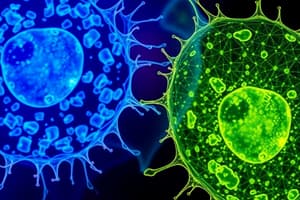Podcast
Questions and Answers
Which of the following describes the primary function of the shoot system in plants?
Which of the following describes the primary function of the shoot system in plants?
- Storing excess food produced during photosynthesis.
- Anchoring the plant in the soil and absorbing water and nutrients.
- Transporting water and nutrients from the roots to the leaves.
- Synthesizing sugars through photosynthesis and enabling reproduction. (correct)
Which animal organ system primarily facilitates the exchange of gases between the organism and its environment?
Which animal organ system primarily facilitates the exchange of gases between the organism and its environment?
- Respiratory system (correct)
- Excretory system
- Circulatory system
- Digestive system
Which of the following plant organs is primarily responsible for the uptake of water and nutrients from the soil?
Which of the following plant organs is primarily responsible for the uptake of water and nutrients from the soil?
- Stem
- Leaves
- Roots (correct)
- Flower
Which of the following represents a key difference in the respiratory systems of frogs compared to humans?
Which of the following represents a key difference in the respiratory systems of frogs compared to humans?
Homeostasis is crucial for the survival of organisms. Which of the following best describes the process of homeostasis?
Homeostasis is crucial for the survival of organisms. Which of the following best describes the process of homeostasis?
Which system is responsible for transporting oxygen, nutrients, and hormones throughout the body?
Which system is responsible for transporting oxygen, nutrients, and hormones throughout the body?
How do the respiratory and circulatory systems work together to maintain homeostasis in animals?
How do the respiratory and circulatory systems work together to maintain homeostasis in animals?
Which of the following describes the main function of the digestive system?
Which of the following describes the main function of the digestive system?
What could happen if the excretory system fails to remove waste products effectively?
What could happen if the excretory system fails to remove waste products effectively?
Which medical condition is directly associated with a failure of the pancreas to regulate blood sugar levels effectively?
Which medical condition is directly associated with a failure of the pancreas to regulate blood sugar levels effectively?
If a plant's root system is damaged, which of the following functions would be most directly affected?
If a plant's root system is damaged, which of the following functions would be most directly affected?
In a human, which structure facilitates the exchange of oxygen and carbon dioxide between the air and the blood?
In a human, which structure facilitates the exchange of oxygen and carbon dioxide between the air and the blood?
How do the leaf and root systems in a plant depend on each other?
How do the leaf and root systems in a plant depend on each other?
Which sequence correctly traces the pathway of air during inhalation in humans?
Which sequence correctly traces the pathway of air during inhalation in humans?
The stomach is an organ that plays a crucial role in which animal system?
The stomach is an organ that plays a crucial role in which animal system?
Which of the following is the primary function of the flower in plant reproduction?
Which of the following is the primary function of the flower in plant reproduction?
Which scenario exemplifies a plant's response to maintain homeostasis?
Which scenario exemplifies a plant's response to maintain homeostasis?
What distinguishes a plant organ from a plant tissue?
What distinguishes a plant organ from a plant tissue?
Considering the differences between frog and human anatomy, which adaptation allows frogs to survive both in water and on land?
Considering the differences between frog and human anatomy, which adaptation allows frogs to survive both in water and on land?
How does the circulatory system respond to a stressful situation requiring increased physical activity?
How does the circulatory system respond to a stressful situation requiring increased physical activity?
Flashcards
Organs
Organs
Structures composed of different tissues working together to perform specific functions. Examples in plants include flowers, roots, stems, and leaves. In animals, examples include skin, heart, stomach and lungs.
Organ Systems
Organ Systems
Collections of organs that work together to perform major bodily functions. In plants these are the root and shoot systems. In animals these include the digestive, circulatory, and respiratory systems.
Homeostasis
Homeostasis
The maintenance of a stable internal environment in the body, despite external changes.
Root System
Root System
Signup and view all the flashcards
Shoot System
Shoot System
Signup and view all the flashcards
Digestive System (Animal)
Digestive System (Animal)
Signup and view all the flashcards
Circulatory System (Animal)
Circulatory System (Animal)
Signup and view all the flashcards
Respiratory System (Animal)
Respiratory System (Animal)
Signup and view all the flashcards
Study Notes
- Organs in plants include the flower, roots, stem, and leaf.
- Organs in animals include the skin, heart, stomach, and lung.
- It is important to understand the function of each organ, be able to label them in diagrams, and know the tissues that compose them.
- Plant organ systems consist of the root and shoot systems.
- Animal organ systems include the digestive, circulatory, and respiratory systems.
- Knowledge of these systems, their functions, pathways, and key structures is essential.
- Understand how and where these systems interact closely, detailing the structures and processes involved.
- Grasp how the systems collaborate and recognize potential medical conditions that may arise.
- Homeostasis is the mechanism by which the body maintains or restores balance after stress.
- There are differences between frog and human systems.
Studying That Suits You
Use AI to generate personalized quizzes and flashcards to suit your learning preferences.




